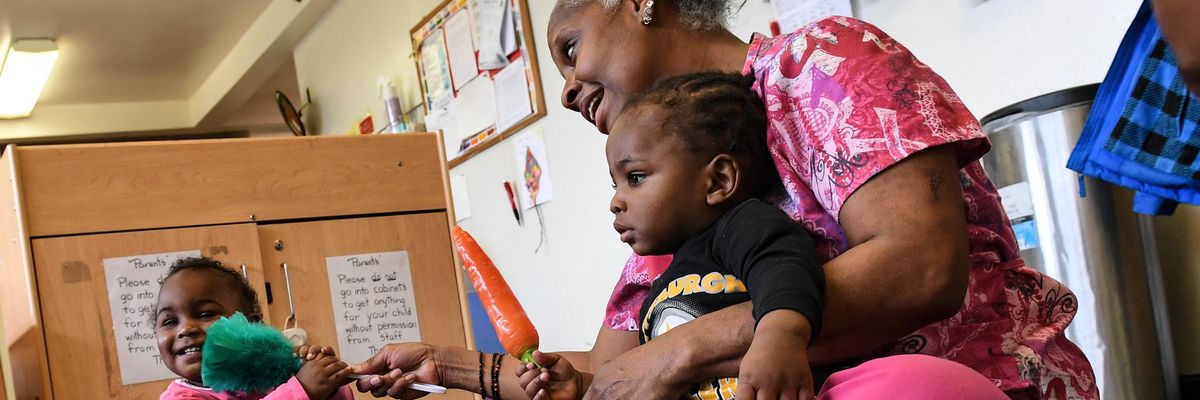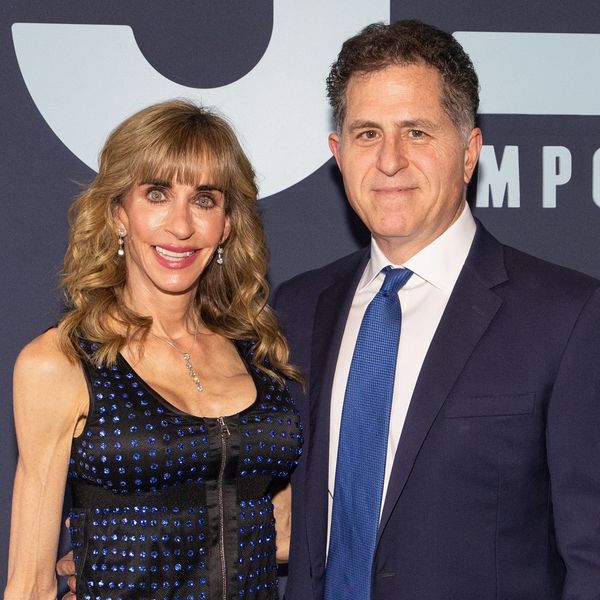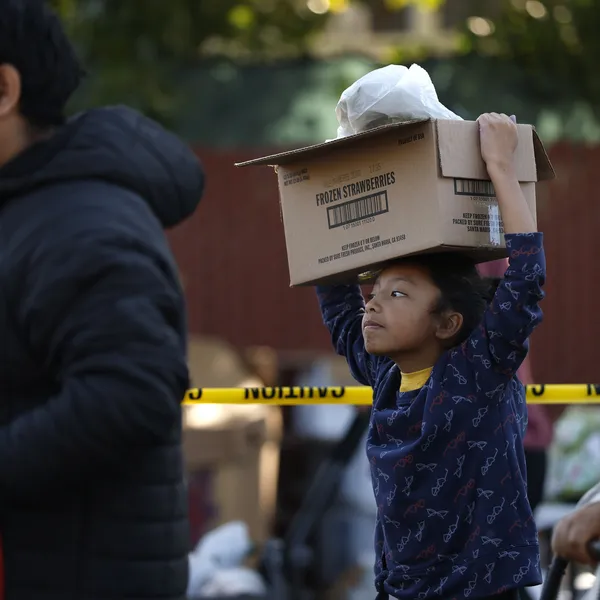
Childcare worker Debbie James-Dean sits with children at a Kids Are Us Learning Center in Washington, D.C., on March 24, 2017.
Congress Must Fund Childcare Initiatives Like the One That Helped Me Escape Poverty
Accessible childcare offers long-term benefits for children, families, and society, including improved educational outcomes, greater workforce participation, and reduced dependence on the social safety net.
On a good day in December 1983, I cooked Vienna sausages and grits on a borrowed kerosene heater that—in my poverty-stricken state—felt like another mouth to feed. Every day I had to buy fuel for it.
I’d vowed to lift myself and two boys out of destitution as soon as I could, either by getting a job or returning to school. But a severe lack of resources, primarily childcare for my toddler, made it nearly impossible to envision either.
Our financial situation was far from secure compared to what it had been the year before. My partner and I both worked, and we enjoyed a comfortable life in a lovely neighborhood. However, his struggles with PTSD from his time in Vietnam led to unpredictable violent outbursts, prompting me to flee with the children for our safety.
Knowing my two-year-old would be properly looked after enabled me to not only attend my classes, but focus on my studies with peace of mind.
With no concrete plan, we ended up briefly homeless, relying on a moving truck and strangers for shelter before ending up in a tiny, unequipped unit in a dilapidated cement tenement.
Sylvia, a friend at church, taught me about Pell Grants, Supplement Education Opportunity Grants (SEOG), and other tools to help me afford an education. Thanks to her, I decided to attend community college.
Sylvia also had the answer to my biggest looming concern—the availability of childcare for my toddler. She said the cost could be covered by a government-subsidized program. And she was right.
Without that support, I couldn’t have taken advantage of any of the other aid. Knowing my two-year-old would be properly looked after enabled me to not only attend my classes, but focus on my studies with peace of mind.
During my second year of college, I completed two unpaid internships: one in a television newsroom, and another at a city lifestyle magazine. That experience helped me get a piece published in a major newspaper, which led to opportunities with local publications. My income increased and stabilized when I became a newspaper staff writer.
Affordable childcare was the key. To this day, nearly 40 years later, I’m still grateful for having received that support and the opportunities for professional growth that came my way. Affordable childcare is bound to be the answer to others’ success, as well.
Accessible childcare offers long-term benefits for children, families, and society, including improved educational outcomes, greater workforce participation, and reduced dependence on the social safety net. But unfortunately, the cost of childcare has skyrocketed since I had young kids. Some families pay up to 30% of their income toward childcare, making it unaffordable almost everywhere in the United States.
I urge members of Congress to fund, support, and expand childcare initiatives. The pandemic-era stabilization funds that saved up to 10 million childcare slots ended last fall, threatening the childcare sector as well as the families, children, and businesses that depend on it. And we’re facing another cliff this fall.
This spring, Community Change Action organized the third Annual National Day Without Childcare, which gave a glimpse of what would happen if providers were all forced to close their doors for good. As a parent and grandparent, I stand in solidarity with them.
If we don’t make a change, all of us will pay the price.
An Urgent Message From Our Co-Founder
Dear Common Dreams reader, The U.S. is on a fast track to authoritarianism like nothing I've ever seen. Meanwhile, corporate news outlets are utterly capitulating to Trump, twisting their coverage to avoid drawing his ire while lining up to stuff cash in his pockets. That's why I believe that Common Dreams is doing the best and most consequential reporting that we've ever done. Our small but mighty team is a progressive reporting powerhouse, covering the news every day that the corporate media never will. Our mission has always been simple: To inform. To inspire. And to ignite change for the common good. Now here's the key piece that I want all our readers to understand: None of this would be possible without your financial support. That's not just some fundraising cliche. It's the absolute and literal truth. We don't accept corporate advertising and never will. We don't have a paywall because we don't think people should be blocked from critical news based on their ability to pay. Everything we do is funded by the donations of readers like you. Will you donate now to help power the nonprofit, independent reporting of Common Dreams? Thank you for being a vital member of our community. Together, we can keep independent journalism alive when it’s needed most. - Craig Brown, Co-founder |
On a good day in December 1983, I cooked Vienna sausages and grits on a borrowed kerosene heater that—in my poverty-stricken state—felt like another mouth to feed. Every day I had to buy fuel for it.
I’d vowed to lift myself and two boys out of destitution as soon as I could, either by getting a job or returning to school. But a severe lack of resources, primarily childcare for my toddler, made it nearly impossible to envision either.
Our financial situation was far from secure compared to what it had been the year before. My partner and I both worked, and we enjoyed a comfortable life in a lovely neighborhood. However, his struggles with PTSD from his time in Vietnam led to unpredictable violent outbursts, prompting me to flee with the children for our safety.
Knowing my two-year-old would be properly looked after enabled me to not only attend my classes, but focus on my studies with peace of mind.
With no concrete plan, we ended up briefly homeless, relying on a moving truck and strangers for shelter before ending up in a tiny, unequipped unit in a dilapidated cement tenement.
Sylvia, a friend at church, taught me about Pell Grants, Supplement Education Opportunity Grants (SEOG), and other tools to help me afford an education. Thanks to her, I decided to attend community college.
Sylvia also had the answer to my biggest looming concern—the availability of childcare for my toddler. She said the cost could be covered by a government-subsidized program. And she was right.
Without that support, I couldn’t have taken advantage of any of the other aid. Knowing my two-year-old would be properly looked after enabled me to not only attend my classes, but focus on my studies with peace of mind.
During my second year of college, I completed two unpaid internships: one in a television newsroom, and another at a city lifestyle magazine. That experience helped me get a piece published in a major newspaper, which led to opportunities with local publications. My income increased and stabilized when I became a newspaper staff writer.
Affordable childcare was the key. To this day, nearly 40 years later, I’m still grateful for having received that support and the opportunities for professional growth that came my way. Affordable childcare is bound to be the answer to others’ success, as well.
Accessible childcare offers long-term benefits for children, families, and society, including improved educational outcomes, greater workforce participation, and reduced dependence on the social safety net. But unfortunately, the cost of childcare has skyrocketed since I had young kids. Some families pay up to 30% of their income toward childcare, making it unaffordable almost everywhere in the United States.
I urge members of Congress to fund, support, and expand childcare initiatives. The pandemic-era stabilization funds that saved up to 10 million childcare slots ended last fall, threatening the childcare sector as well as the families, children, and businesses that depend on it. And we’re facing another cliff this fall.
This spring, Community Change Action organized the third Annual National Day Without Childcare, which gave a glimpse of what would happen if providers were all forced to close their doors for good. As a parent and grandparent, I stand in solidarity with them.
If we don’t make a change, all of us will pay the price.
- 'Families' Needs Over Corporate Greed': US Childcare Providers, Parents Hold Day of Action ›
- Senate Report Warns Inaction Pushing US Childcare System to 'Brink of Collapse' ›
- To Avert Looming Childcare Disaster, Murray and Sanders Lead Emergency Funding Bill ›
- As GOP Threatens Shutdown, US Childcare Catastrophe Just Weeks Away ›
- 3.2 Million Kids Could Be Thrown Off 'Childcare Cliff' in September—Unless Congress Acts ›
- 'They Still Failed Millions of Children': Congress Averted a Shutdown, But Not a Childcare Cliff ›
On a good day in December 1983, I cooked Vienna sausages and grits on a borrowed kerosene heater that—in my poverty-stricken state—felt like another mouth to feed. Every day I had to buy fuel for it.
I’d vowed to lift myself and two boys out of destitution as soon as I could, either by getting a job or returning to school. But a severe lack of resources, primarily childcare for my toddler, made it nearly impossible to envision either.
Our financial situation was far from secure compared to what it had been the year before. My partner and I both worked, and we enjoyed a comfortable life in a lovely neighborhood. However, his struggles with PTSD from his time in Vietnam led to unpredictable violent outbursts, prompting me to flee with the children for our safety.
Knowing my two-year-old would be properly looked after enabled me to not only attend my classes, but focus on my studies with peace of mind.
With no concrete plan, we ended up briefly homeless, relying on a moving truck and strangers for shelter before ending up in a tiny, unequipped unit in a dilapidated cement tenement.
Sylvia, a friend at church, taught me about Pell Grants, Supplement Education Opportunity Grants (SEOG), and other tools to help me afford an education. Thanks to her, I decided to attend community college.
Sylvia also had the answer to my biggest looming concern—the availability of childcare for my toddler. She said the cost could be covered by a government-subsidized program. And she was right.
Without that support, I couldn’t have taken advantage of any of the other aid. Knowing my two-year-old would be properly looked after enabled me to not only attend my classes, but focus on my studies with peace of mind.
During my second year of college, I completed two unpaid internships: one in a television newsroom, and another at a city lifestyle magazine. That experience helped me get a piece published in a major newspaper, which led to opportunities with local publications. My income increased and stabilized when I became a newspaper staff writer.
Affordable childcare was the key. To this day, nearly 40 years later, I’m still grateful for having received that support and the opportunities for professional growth that came my way. Affordable childcare is bound to be the answer to others’ success, as well.
Accessible childcare offers long-term benefits for children, families, and society, including improved educational outcomes, greater workforce participation, and reduced dependence on the social safety net. But unfortunately, the cost of childcare has skyrocketed since I had young kids. Some families pay up to 30% of their income toward childcare, making it unaffordable almost everywhere in the United States.
I urge members of Congress to fund, support, and expand childcare initiatives. The pandemic-era stabilization funds that saved up to 10 million childcare slots ended last fall, threatening the childcare sector as well as the families, children, and businesses that depend on it. And we’re facing another cliff this fall.
This spring, Community Change Action organized the third Annual National Day Without Childcare, which gave a glimpse of what would happen if providers were all forced to close their doors for good. As a parent and grandparent, I stand in solidarity with them.
If we don’t make a change, all of us will pay the price.
- 'Families' Needs Over Corporate Greed': US Childcare Providers, Parents Hold Day of Action ›
- Senate Report Warns Inaction Pushing US Childcare System to 'Brink of Collapse' ›
- To Avert Looming Childcare Disaster, Murray and Sanders Lead Emergency Funding Bill ›
- As GOP Threatens Shutdown, US Childcare Catastrophe Just Weeks Away ›
- 3.2 Million Kids Could Be Thrown Off 'Childcare Cliff' in September—Unless Congress Acts ›
- 'They Still Failed Millions of Children': Congress Averted a Shutdown, But Not a Childcare Cliff ›

